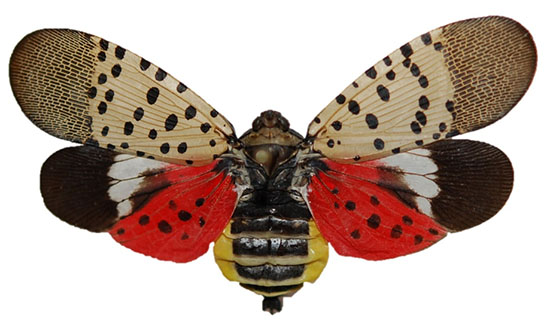Issue 10, June 29, 2015
Invasive Species Spotlight: Spotted Lantern Fly
Today's global economy provides ever increasing opportunities for invasive pests to enter and exit our country. One recent and newsworthy example of such an accidental introduction is that of the spotted lanternfly (Lycorma delicatula), a planthopper (Hemiptera: Fulgoridae) native to Asia, being detected in Berks County, Pennsylvania in September of 2014. Thought to have arrived into the state via infested landscaping materials, the U.S. Department of Agriculture's Animal and Plant health Inspection Service (APHIS) along with multiple state's departments of agriculture have worked vigorously to contain the pest within the Pennsylvania border, and to stop it from spreading into other states within the U.S.
Concern over spotted lanternfly stems from its potential to damage multiple valuable tree and fruit crops, including grapes, apples, ornamental trees, and pines. While adult lanternflies primarily reside and lay eggs on tree of heaven (Ailanthus altissima), immature lanternflies (nymphs) tend to feed upon many more plant varieties, and cause damage to plants by feeding upon the sap of stems and leaves. The fact that humans have the potential to unknowingly aid in the dispersal of the pest by long distance travel of materials and vehicles infested with the pest's egg masses, spotted lanternfly could pose a serious threat to our country's grape, orchard and logging industries. Within Illinois, emphasis has been placed on the pest's potential impact on grape vineyards if it were to expand its range into the state.
One can best help combat and slow the spread of spotted lanternfly by first properly identifying the pest. Lanternfly egg masses are laid in groups of 30-50 and covered by a brown yellow wax deposit. Immature spotted lanternflies (nymphs) are black with white spots, and develop red spots on their wing pads and thorax as they mature. Adult spotted lanternflies are present from July into November, and feed predominantly upon Tree of Heaven (Ailanthus altissma) and grape vines. At rest, adults display forewings that are light brown with black spots at the front and a speckled band at the rear that are held above their body in a "tent-like" manner. When disturbed, adults lift their forewings to expose hind wings which are scarlet with black spots at the front and with white and black bars at the rear. In addition, adults have yellow abdomens with black horizontal bars and are typically 1 inch long and 0.5 inches wide.

Spotted lanternfly adult at rest. Photo taken by Audie Wilkins (www.projectnoah.org)

Spotted lanternfly adult with hindwings exposed. Photo taken by Holly Raguza, Pennsylvania Department of Agriculture.
Though currently only found in Pennsylvania, this is an invasive that is a concern for Illinois. If you suspect spotted lanternfly is your area, please contact Illinois' Agricultural Pest Survey Coordinator Kelly Estes (kcook8@illinois.edu) at 217-333-1005. Adult, nymph, or egg samples (placed in alcohol or hand sanitizer in a leak proof container) can be sent to 1816 South Oak Street, Champaign, IL 61820 for proper identification. (Gabe Foote (CAPS intern), Kelly Estes)
Author:
Kelly Estes